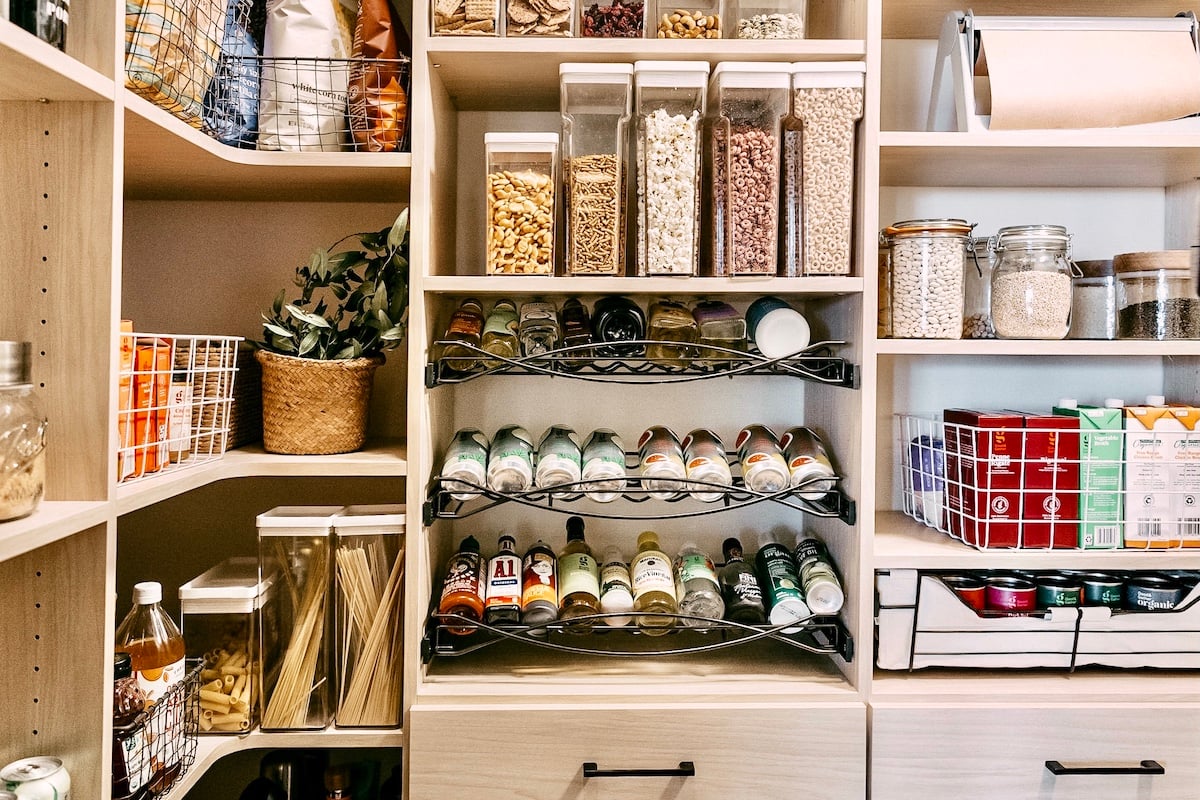The #1 Kitchen Hack That’ll Transform Your Cooking Routine
We're nuts about this one.

We’ve all been there: It’s 3 p.m. and a cookie craving strikes. You ditch all your other tasks and preheat the oven, grab your baking sheet, and head to the pantry. Inevitably, it’s a bit of an eyesore. You regret not organizing your cluttered, overflowing shelves (but don’t fret, we’ve got tips). Behind the half-eaten bags of cereal and tortilla chips are your flours. The shelf is caked with a thin layer of dust. Hoping for the best, you check the best-by date. It expired in 2021. Oops. You let out a sigh, opt for a handful of packaged cookies, and head back to your desk. Sound familiar?
If so, today we’re sharing how to store nuts, seeds, and flours. Don’t fall victim to rancid seeds or stale flours! Because drool-worthy recipes, like this, are worth the fresh ingredients.
Feature image by Michelle Nash.
Nuts, Seeds, and Flours Have a Limited Shelf Life
A well-stocked kitchen is our love language. If you’re anything like us, nuts, seeds, and flours are staples. They find their way into granola, muffins, and of course, sweet loaves and snack-worthy breads. We often find ourselves in the bulk bin section of the grocery store, filling our bags with walnuts, almonds, pumpkin seeds, and hemp hearts.
Unfortunately, not knowing how to store nuts, seeds, and flours can lead to food waste. They have a limited shelf life. Nuts and seeds contain a reasonably high amount of oil, and these healthy fats are delicate. When exposed to heat, light, and oxygen, they can turn rancid. This results in a harsh, bitter taste (and stomach pain). Similarly, flours also have an expiration date.
The Best Way to Tell If Your Flour Has Expired
As with all packaged foods, flours have a best-by date (expiration date) printed on the bag. This indicates its freshness. However, these labels aren’t mandatory. They don’t denote safety. Therefore, your flour may still be safe to eat even after the best-by date.
The best way to determine whether your flour is safe? Smell it. While fresh flour has a neutral odor, bad flour smells off—it can be stale, musty, or almost sour. It may also look discolored. Additionally, if your flour has come into contact with water or moisture, large clumps of mold may appear. In this case, you should immediately discard the entire bag.
Shelf Life of Various Types of Flour
With their varying nutritional profiles and processing methods, some flours have a longer shelf life than others.
Refined flours
These have the longest shelf life. They can keep for anywhere from six months to two years. Examples include:
All-purpose flourWhite bread flourWhite cake flourWhite pastry flourWhite self-rising flour Other white, starch-based flours (like potato and tapioca flours)Whole-wheat flours
These flours have a much shorter shelf life than refined flours. Whole-wheat flours contain the grain’s bran and germ (meaning they’ve been processed less). While that means they’re rich in fiber, nutrients, and healthy oils, they spoil faster and are more sensitive to light, moisture, and air. Depending on how they’re stored, whole-wheat flours will keep for 3-4 months. This category includes:
White whole-wheat flourPumpernickel flourWhole and medium rye flourBuckwheat flourWhole-grain flour blendsGluten-free flours
Gluten-free flours (and flour blends) often contain nut or root flours, which makes them quicker to spoil. You can expect them to last 3-6 months, depending on storage.
Nut flours
Almond, coconut, and other nut flours contain nut oils that make them spoil faster than wheat-based flours. Like gluten-free flours, nut flours will keep for 3-6 months, depending on storage.
Tips and Tricks: Prevent Flour From Going Stale
First and foremost, let’s talk about packaging. Most flours come in a paper bag, which is not airtight. That means moisture can get into the flour. Even more unpleasant are tiny bugs and pests that can get into the bag, too. To keep flour as fresh as possible, follow these steps:
When you get home from the grocery store, put your new bag of flour in the freezer. Leave it there for a few days. Transfer the flour out of the bag and into an an airtight container. A plastic storage container with a tight lid is ideal (here are extra-large containers), but a large reusable bag is totally fine, too. Any type of impermeable container will keep out pests as well as moisture. Store in the pantry, but avoid warm, sunny spots. A cool, dry place is best.That said, to keep flour super fresh, store it in the freezer or fridge (an airtight container is still best). This might be an especially good idea if your house runs warm, if you live in a humid climate, or if you don’t go through flour very quickly.
Can You Use Expired Flour?
Unless your flour looks (or smells) like it has gone rancid or stale, you can cook and bake with it. That said, you can use expired flour in a variety of other ways. For example, it works as insect repellant, homemade glue, stainless steel cleaner, a face mask, play dough, and more. For more DIY options, see here. Otherwise, you can compost expired flour.
Nuts and Seeds: Approximate Shelf Life
Onto nuts and seeds. For an easy, printable guide, see below.
| NUT / SEED | PANTRY | FRIDGE | FREEZER |
| Almonds | 9 months | 1 year | 1-2 years |
| Cashews | 9 months | 1 year | 2 years |
| Walnuts | 6 months | 1 year | 2 years |
| Pecans | 6 months | 1 year | 2 years |
| Peanuts | 1 month | 4-6 months | 1 year |
| Pistachios | 3 months | 1 year | 3 years |
| Pumpkin Seeds | 3 months | 6 months | 1 year |
| Hemp Hearts | 3-4 months | 1 year | 1 year |
| Chia + Flax Seeds | 1 year (unmilled) | 2 years | 3-4 years |
4 Ways to Prevent Nuts and Seeds From Going Rancid
To help extend their shelf life, make sure to store your nuts and seeds properly. You’ll get the hang of how to store nuts, seeds, and flours in no time.
Buy them fresh.
When possible, buy the freshest nuts and seeds you can find. Farmers markets are great for this. Otherwise, bulk bins are often a good place to look (because they tend to have a quick turnaround and are restocked often). If possible, taste before you buy to ensure freshness. Also, try to only buy what you need.
Buy raw nuts and seeds, whole.
Raw nuts and seeds will stay fresh, the longest, when they’re whole. Once chopped, toasted, or ground into flour or meal, nuts release their oils. As mentioned, these oils are then exposed to more oxygen, which makes them go rancid more quickly. Get in the habit of toasting or grounding nuts/seeds at home. Not only does this guarantee freshness, but also your toasted walnuts, almond butter, and flaxseed meal will taste better.
Use airtight containers.
Same as flour! Once you return home from the store, transfer your nuts and seeds to airtight containers. Empty pasta bottles or mason jars work, too! This keeps air out—which results in fresher nuts—and prevents outside odors from getting in.
Take advantage of the freezer.
Storing your nuts and seeds in airtight containers is the first step, but it’s even more important to keep them chilled. You’ll notice a theme with how to store nuts, seeds, and flours: the colder, the better. If you plan to use them in the immediate future, it’s fine to store the airtight containers in a cool, dark spot in your pantry. To keep them fresh for much longer, store your nuts and seeds in the refrigerator or the freezer. That way, they’ll be unaffected by fluctuating kitchen temperatures.
We hope this guide to how to store nuts, seeds, and flours is helpful! Drop any tips and tricks into the comments below.

 Konoly
Konoly 































